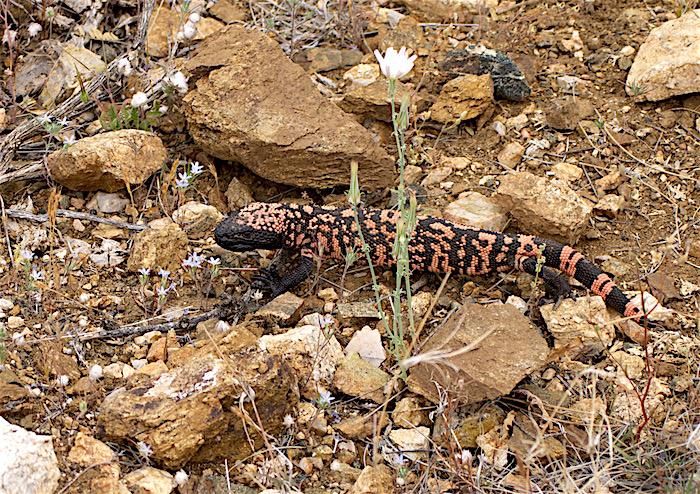
April is peak wildflower time in Saguaro National Park, as evidenced in the Cactus Forest of the Rincon Mountain District/Kurt Repanshek file photo
As the snow continues to pile up in the Rockies, thoughts not surprisingly turn to warmer settings, and Saguaro National Park in southern Arizona is a great place to explore in early spring. Wildflowers are coming up, temperatures are warming, but not too hot or too cold, and crowds seemingly have gone elsewhere.
With the wildflowers seeming to peak in April, now is a great time to start planning a Saguaro getaway. Southern Arizona has seen an unusual amount of rain this winter, and so the wildflower bloom should be incredible. Last March a BioBlitz was conducted in the park and volunteers were able to identify nearly 100 plant species, so there will be plenty of color to go around.
You can surround yourself in the color by hiking the Cactus Forest in the Rincon Mountain District to the east of downtown Tucson. Hike out the Douglas Spring Trail and on to Bridal Wreath Falls, where hanging gardens are nourished by the falling waters...which can either be a trickle, or a torrent, depending on recent rains.

Keep an eye on the ground while you hike for both rattlesnakes and gila monsters/Kurt Repanshek file photo
While you're hiking in the forest, be sure to keep an eye out for Gila woodpeckers and gilded flickers that whittle out cavities in saguaros for their nests. At the same time, don't forget to watch where you step, as rattlesnakes and gila monsters also make this area their home.
Another great stop when you're visiting Saguaro is the Arizona-Sonora Desert Museum in the Tucson District to the west of downtown. This indoor-outdoor museum really drills down into the ecology of the Sonoran Desert. Within the museum's plant and animal collection are 20 endangered or threatened species.The museum also serves as a genetic refuge for "three endangered native fish, one state endangered snake, and several endangered plants."
After exploring the exhibits in inside the museum, head out and walk the trails on the property. The trails lead to some pretty interesting displays/exhibits, such as the Hummingbird Aviary and the Walk-in Aviary, where 40 bird species live, including Cardinals, Gambel's quail, and the Greater roadrunner.
If you block out enough time for your southern Arizona dose of warmth, consider heading west about two hours to Organ Pipe Cactus National Monument. Back in September 2014 the monument staff was able to open the Quitobaquito area of the park with its historic irrigation canals and life-giving waters. That was the first time since 2003 that the public was allowed to enter this part of Organ Pipe. It was closed following the murder of Ranger Kris Eggle, who was shot and killed in August 2002 while pursuing members of a drug cartel in the southern reaches of the monument.
The public seemed to relish the reopening of previously closed areas of Organ Pipe, for overall visitation in 2015 was a healthy 10.65 percent higher than in 2014 (1,217,000 vs. 1,099,910). What's to do in Organ Pipe? Desert photography, birding, night sky viewing, and scenic drives.

Sunsets over Organ Pipe Cactus National Monument are worth the price of admission/NPS
Traveler footnote: Be sure to check out Friends of Saguaro National Park. They work hard to make a lot of things possible at Saguaro National Park and could use your support!


 Support Essential Coverage of Essential Places
Support Essential Coverage of Essential Places







Comments
Organ Pipe Cactus NM is certainly a spectacular destination, but I think the visitation numbers for both 2014 & 2015 are way too high... much higher than even at the more-accessible Saguaro NP. According to nps.gov/stats, visitation to Organ Pipe was 224,548 in 2014; that's the most recent year for which they've published figures.
Dick, you raise an interesting point. Using nps.gov/stats, if you look at the annual visitation by year, you get the 224,548 figure you cite, but if you go to Monthly Public Use stats they show the stats mentioned in the story. But what's even more interesting is that the monthly "non-recreational visits" are more than double the "recreational visits."
The stats could be totally askew, but they also merit a phone call. Thanks for pointing out the other number.
Hmmm, "Non-Recreational" makes me wonder... Organ Pipe is on AZ Route 85, which is the road that leads to/from Puerto Pensaco, Mexico, a popular recreational destination for Arizonans. (Puerto Penasco is on the Gulf of California, and it has been nicknamed "Arizona's Beach".) There's a fairly sizeable town just across the border in Mexico (13,000), no more than 8-10 miles away, so there's probably some traffic moving from that direction as well, with folks coming to the US to shop. Also, there's lots of commercial traffic on the road.
I wonder if the higher total includes the motorists who are speeding through Organ Pipe on their way to and from Mexico, and who probably don't even know they're in a national monument? (Some probably do make a quick pit-stop, as facilities are pretty much non-existent otherwise.)
I'll be interested in hearing the results of your phone call!
I visited the museum maybe 10 years ago. It's like no other museum I've ever seen. Rather than dusty antiquities behind glass, it showcases wonderful living and breathing species. My favorite? The Elf Owl! Definitely worth a visit. I envy people who live nearby and can visit regularly.
P.S. -- as a journalist, my eye immediately went to the misspelling of Tucson. I hope someone can fix that.
Dick, you're absolutely right. NPS folks tell me that 95 percent of the traffic on Highway 85 is considered "non-recreational" visitation, hence the large numbers.
And Virginia, thanks for your sharp eyes. We've fixed the misspelling.
Thanks for the fast follow-up, Kurt.